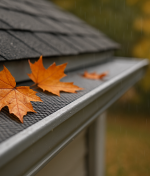Fall is the perfect time to tune up your roof, gutters, and ventilation before winter sets in across Nebraska and Iowa. The trouble is that bad advice spreads quickly. These roof maintenance myths sound harmless, yet they lead to leaks, moisture issues, and early replacements. Use this guide as your winter roof prep checklist to separate fact from fiction and to plan quick checks you can do from the ground.
Myth 1: “If it is not leaking, it is fine.”
Reality: Most leaks start small at flashing and edges. By the time water reaches drywall, insulation and roof decking may already be wet.
What to check this fall
- Look from the ground for missing or curled shingles
- Sight along chimneys for metal that looks loose or out of sequence
- Scan valleys for straight, open water paths
Pro fix: Schedule a roof flashing inspection that includes chimney bases, sidewalls, and valleys. Tight metal details stop winter water entry long before stains appear indoors.
Myth 2: “Gutter guards mean no more cleaning.”
Reality: Quality guards reduce debris, but outlets still collect grit and seeds. A blocked elbow sends water over the front lip and behind fascia.
What to check
- After rain, watch the first elbow for slow flow
- Look for staining behind gutters that suggests water bypass
- Confirm guard panels sit flat and secure
Pro fix: Pair guards with correct pitch, strong hangers, and right-size outlets. Add these fall gutter maintenance tips to your routine: quick outlet checks, a hose rinse at stubborn elbows, and fast debris removal near roof valleys.
Myth 3: “More attic insulation will stop ice dams.”
Reality: Insulation matters, but airflow matters too. Without balanced intake and exhaust, warm attic air heats the deck from below, snow melts, and refreezes at cold eaves.
What to check
- Make sure soffit openings are clear
- Add baffles where insulation touches the deck
- Confirm you have continuous ridge exhaust
Pro fix: Request an attic ventilation assessment. A simple rule of thumb is one square foot of net free vent area for every 300 square feet of attic floor when a vapor barrier is present. Balance intake at soffits with exhaust at the ridge to support ice dam prevention.
Myth 4: “Caulk will fix flashing problems.”
Reality: Surface sealant dries and cracks. Properly lapped metal is the durable answer.
What to check
- Counter flashing should tuck into masonry grooves
- Step flashing should appear as small, even pieces paired with each shingle course
- Valleys should have a clear center channel, not tight shingle cuts in the flow line
Pro fix: Choose real metal replacement, not a bead of caulk. Correct details last through freeze and thaw.
Myth 5: “All underlayments are the same.”
Reality: Field underlayment and leak barriers do different jobs. Synthetic sheets resist tearing and heat during staging. Ice and water shield seals around nails at eaves, valleys, and penetrations.
What to check
- Ice barrier present at eaves and valleys
- Synthetic underlayment across the field
- Drip edge layered in the correct order at eaves and rakes
Pro fix: If you plan roof work, confirm the underlayment sequence in writing so the base layers protect the deck when winter weather arrives.
Myth 6: “Power washing is a good way to clean shingles.”
Reality: High pressure strips granules, shortens life, and can force water under laps.
What to do instead
- Use manufacturer approved cleaning methods or hire a pro who follows them
- Address discoloration by improving shade and moisture conditions, not by blasting the surface
Myth 7: “Wind damage only matters after a big storm.”
Reality: Repeated gusts during fall fronts crease tabs, lift caps, and loosen nails. Small wind events add up.
What to check
- Tabs that look lifted or creased from the ground
- Minor splits at ridge corners
- Exposed nail heads near vents or accessories
Pro fix: Targeted ridge cap repair and valley flashing repair now prevents winter water entry later. Small fixes today keep you out of emergency mode in January.
Your 15 minute fall checklist
Use this for a fast, ground-level review.
- Walk the property and look for missing or curled shingles
- Check gutters for standing water a day after rain
- Clear outlet elbows and rinse tough clogs with a hose
- Confirm soffit vents are open and baffles keep insulation pulled back
- Look up at valleys and chimneys for clean, tight flashing lines
- Verify ridge vent is continuous with no blockages at the peak
- Book a roof flashing inspection if anything looks off
Add these to your winter roof prep checklist and you will head into cold weather with confidence.
| Myth | Reality | What To Do Now |
|---|---|---|
| If it is not leaking it is fine | Leaks start small at flashing and edges | Schedule a roof flashing inspection this fall |
| Gutter guards end cleaning | Outlets can still clog | Follow fall gutter maintenance tips and rinse elbows |
| More insulation stops ice dams | Balanced airflow prevents ice dams | Get an attic ventilation assessment and add baffles |
| Caulk fixes flashing | Correct metal and laps stop leaks | Replace step and counter flashing where needed |
| All underlayments are the same | Field sheets and ice barrier do different jobs | Confirm synthetic field plus ice and water at eaves and valleys |
| Power wash for a clean roof | Pressure strips granules | Use approved cleaning or call a pro |
| Wind damage only after big storms | Small gusts crease tabs over time | Schedule ridge cap repair and valley flashing repair as needed |
Ready for a fast, no pressure fall check
Do not climb the roof. Stay safe and let a pro handle it. Turtle Roofing will inspect your system, explain what we see, and offer straight advice. If your roof is healthy, we will say so. If you need a small repair or a larger plan, you will have clear options.
Protecting Your Shell across Nebraska and Iowa with careful checks, clean repairs, and honest guidance before winter begins.





